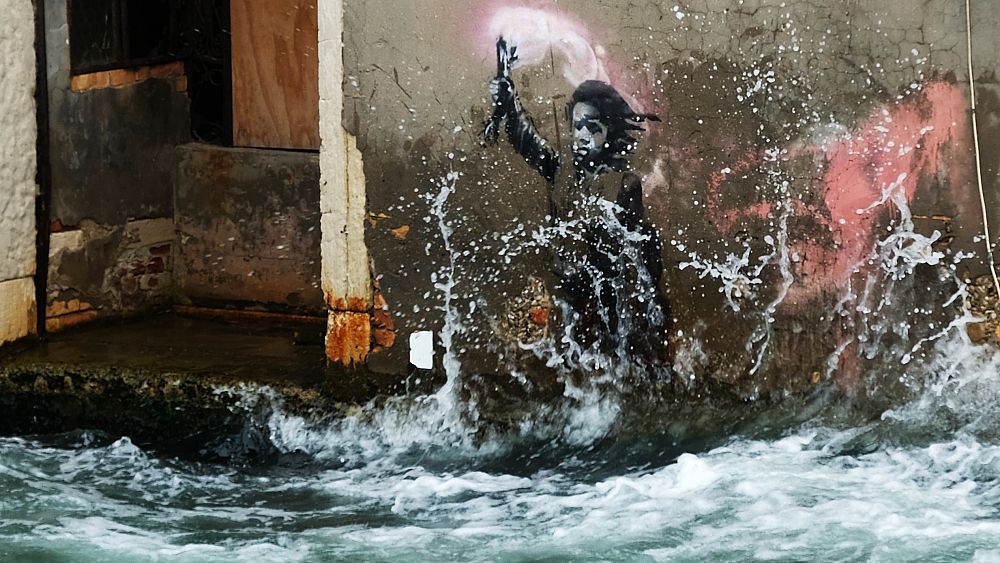The Italian Ministry of Culture wants to restore a work by Banksy, but some artists argue it should be allowed to disappear naturally.
Painted on the wall of an abandoned Venetian palace, Banksy’s 2019 Biennale of Contemporary Art creation, ‘The Migrant Child’, has become a tourist attraction in the City of Canals. However, due to humidity and salt, the artwork depicting a child wearing a life jacket and holding a torch is slowly fading away.
Serving as a commentary on the global refugee crisis but also raising questions about the transient nature of art, this work is also at the centre of an increasingly bitter battle over its restoration.
In a bid to save it, the owner of the building requested the Sopraintendenza dei Beni Culturali (Superintendence of Cultural Heritage) to intervene but the body responsible for the preservation of cultural heritage said it wasn’t qualified to deal with such a recent piece.
The mayor of the city, Luigi Brugnaro, and the president of the Veneto region, Luca Zaia, reached out to Vittorio Sgarbi, the under-secretary for Culture in Giorgia Meloni’s government for help. The latter took it upon himself to restore the work known as ‘The Migrant Child’ through private funding by an Italian bank and it sparked anger among local architectural and artistic communities.
‘Surface of sacrifice’
The Rio Novo neighbourhood, where the stencil is located, is one of the busiest in the city, connecting the railway station to the Grand Canal. The passage of motorboats causes what the Venetians call “moto ondoso,” waves that contribute to the erosion of the lagoon.
This phenomenon is considered a major emergency by UNESCO due to its devastating effects on the environment and the city’s historical infrastructure.
“The lower part of Venetian palaces, in contact with the water, is referred to in architecture as the ‘surface of sacrifice,'” explains Monica Gambarotto, a Venetian tour guide. “It is typically left in bare brick, unpainted, to prevent canal water from rising and being absorbed by the covering.”
Two opposing ends of street art
The proposal by Italy’s Undersecretary for Culture has also been dismissed by local artists. “Banksy was no fool; he was fully aware that his waterside creation wasn’t meant to endure. Restoring it goes against the grain,” said Evyrein, an artist, known for stenciled characters reminiscent of Banksy’s style. He added: “I’ve experienced having one of my own pieces restored with the best intentions, and despite the heartfelt gesture, the end result was less than desirable. If I were ever asked to alter a fellow artist’s work, I would decline unless I had their explicit consent.”
Rosanna Carrieri, an activist from the Mi Riconosci association collaborating with professionals in the cultural sector, emphasised the significance of engaging key stakeholders in these decisions. “Prior to initiating any restoration efforts, it is imperative to consult both the artist and the local community; otherwise, it risks becoming a top-down endeavour capitalizing on Banksy’s fame,” she stressed.
When approached by Euronews Culture, Sgarbi, suggested the work is now property of the local authorities: “I have no intention of consulting the artist: the artwork was created illegally, and we can do as we please with it.”
At the same time, he acknowledged the value of the artwork, stating, “Many tourists photograph it, so it has significant sociological value.”
Sgarbi added that the restoration will be entrusted to Federico Borgogni, who has previously carried out a “rescue operation” for a Banksy stencil in Bristol.
Street art tourism
Monica Gambarotto, a local tourist guide, has witnessed the artist’s impact on the Venetian art scene. Her agency, Guided Tours in Venice, has even curated a dedicated tour to showcase Banksy’s influence on this iconic city.
“The idea is to offer a leisurely stroll to uncover the world of street art in Venice. Some artworks have already vanished, such as those created by Blub (anonymous street artist from Florence). These pieces, being on paper, are more susceptible to tearing or vandalism,” Monica Gambarotto explains. “While our dedicated street art tour is not in high demand, it is more common for tourists to request to include Banksy in a customised tour.”
She stressed the complexity of the decision-making process in regard to restoration based on contradictions. “In the past, nearly all Venetian palaces were adorned with frescoes, which, over time, have naturally faded away. It’s part of the city’s historical evolution. (…) On the flip side, any act of transient vandalism, like what street art often represents, becomes a historical testament. In this regard, Banksy’s work remains an important document even today.”
The troubles of Venice
Critics of the restoration point out that Venice has more urgent issues in need of funding. Matteo Pandolfo, a member of the Venetian Architects Association, said: “This palace has been empty for decades, although the city faces a housing shortage.”
“We should be concerned about Venice’s delicate balance disrupted by tourism, rather than the restoration of a work created to vanish,” agreed Rosanna Carrieri.
‘We must consider the issue of safeguarding artworks in general: the ministry lacks personnel, especially art historians, to ensure the preservation and accessibility of artworks. Drawing attention to ‘The Migrant Child’ empties the work of its social and political meaning,” she added.

